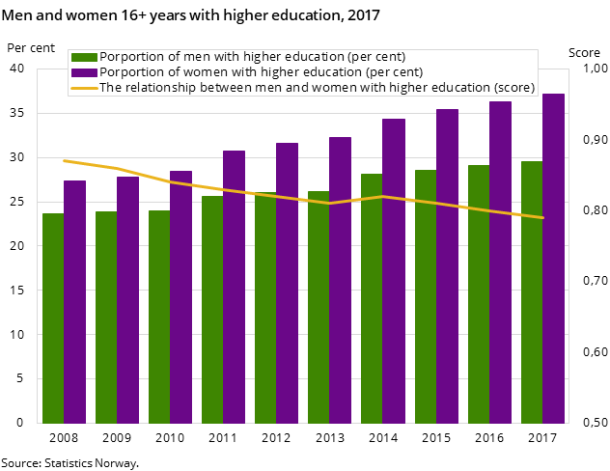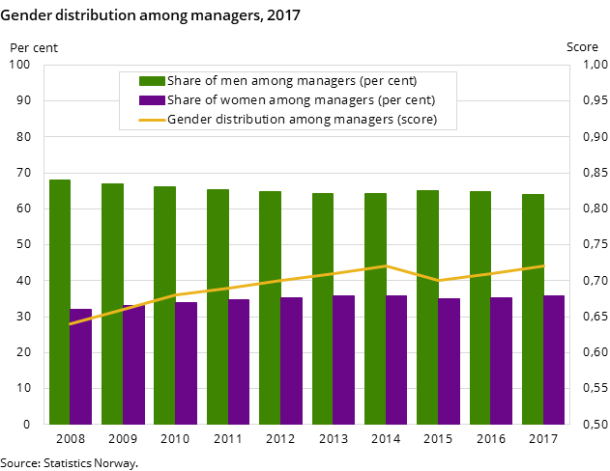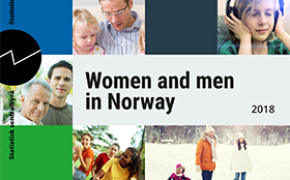Education gap widens
Published:
The gender gap in education is widening every year. In many Norwegian municipalities the proportion of highly educated women is more than twice as large as the proportion of men.
- Full set of figures
- Indicators for gender equality in municipalities
- Series archive
- Indicators for gender equality in municipalities (archive)
Higher education is becoming increasingly important for entering the labour market and is crucial to earnings potential and career opportunities.
For both men and women, there has been a steady increase in the proportion with higher education in recent years according to Statistics Norway’s Indicators for gender equality.
In spite of this, Statistics Norway's indicators for gender equality show that the indicator that measures the relationship between men's and women's educational level is the indicator that most clearly measures a lower score in the period 2008-2017. This is because the gender disparity is steadily increasing in women’s favour. In 2017, women had a higher level of education than men in all the country's 426 municipalities.
The gender disparity in education is especially great in the northernmost counties. Of the 20 municipalities where the gender disparity is the greatest, 14 municipalities lie in Nordland, Troms or Finnmark, and 8 of the 14 are Finnmark municipalities. In 33 of the country's municipalities, the proportion of women with a higher education is more than twice the proportion of men. In Guovdageaidnu - Kautokeino, where the gender disparity is greatest, 43 per cent of women have a higher education, which is 26 percentage points higher than men. The gender disparity in education is the lowest in Oslo and Akershus and in the big cities. However, women's level of education also increases in relation to men's in these areas.
Fewer gender disparities among managers
The widening gender gap in education and its prominence in many of the country's municipalities may prove to have an impact on gender equality in the local labour market in the long term. We see, for example, that the indicator that measures the proportion of women and men among managers in the municipalities has also shown fewer gender disparities in recent years, as figure 2 shows. Although there are still large gender disparities on a national basis, there has been a trend towards a more even gender balance among managers in all counties in Norway and the vast majority of municipalities. This may be an indication that highly educated women’s career opportunities in the local labour market are improving.
Most equal at management level in Oslo
Despite a general development towards better gender balance among managers, there are nevertheless large regional differences. Among the counties, it is Oslo and the three northernmost counties that have the highest score on the indicator that measures the distribution of leaders, while Vestfold scores the lowest. Among the municipalities, 22 of the 30 with the lowest scores are in Southern and Western Norway, while those with the highest scores are more dispersed, but with an overweight in the three northernmost counties. This regional pattern with a high degree of gender balance among the leaders of the northernmost counties can be linked to the fact that there are far more highly qualified women than men who are resident in these counties. Although there are exceptions, there appears to be a pattern, both at the county and municipal level, in which there are more female managers in areas where there is a wide education gap and the proportion of women with a higher education is also relatively large.
Gender disparities in income and part-time work
The large disparities in income level and part-time work have been an ongoing gender equality challenge for all Norwegian municipalities and counties. Of all the twelve indicators that measure local equality, these two indicators have the lowest score in the majority of municipalities. The income level for women is, among other things, the result of part-time work, and in municipalities with widespread part-time work among women, we also find the largest income disparities.
If you see the country as a whole, there has been a slight change towards higher scores, both in terms of gender disparities in income and part-time working. In 2017, men had an average gross income of NOK 533 900, while the corresponding figure for women was NOK 369 600. This means that women's income in 2017 amounted to 69 per cent of men's income, two percentage points more than in 2016.
However, there are again large regional differences. In the municipalities of Austervoll and Sandøy, men's income is twice that of women, while the income distribution is almost the same in Kárásjohka - Karasjok, where women's income is 97 per cent of men's. In Austervoll, however, men earn twice as much as men in Kárásjohka - Karasjok. At county level, Hordaland and Møre- og Romsdal, together with the other Southern and Western counties, are those with the lowest scores when it comes to income distribution, while the highest score is in Finnmark. The high scores in Finnmark are due to the fact that men earn far below the male average in Norway, and not because women have particularly high Incomes.
Majority of employed women in part-time work in almost 100 municipalities
A large gender pay gap in a municipality is often linked to widespread part-time work among women. In Sandøy municipality, which has the widest pay gap in Norway, we also find the lowest score on the relationship between women and men's part-time work. Here, 4 per cent of men and 45 per cent of women work part time. However, the highest proportion of part-time working women is found in Audnedal municipality in Vest-Agder, where 69 per cent of women between the ages of 20 and 66 work part time. In almost 100 municipalities, more than half of the women work part time. In Vadsø, Bærum and Oslo municipality, the proportion of part-time employees among women is the lowest, at around 20 per cent.
Contact
-
Kristin Egge-Hoveid
-
Lene Sandvik
-
Statistics Norway's Information Centre




